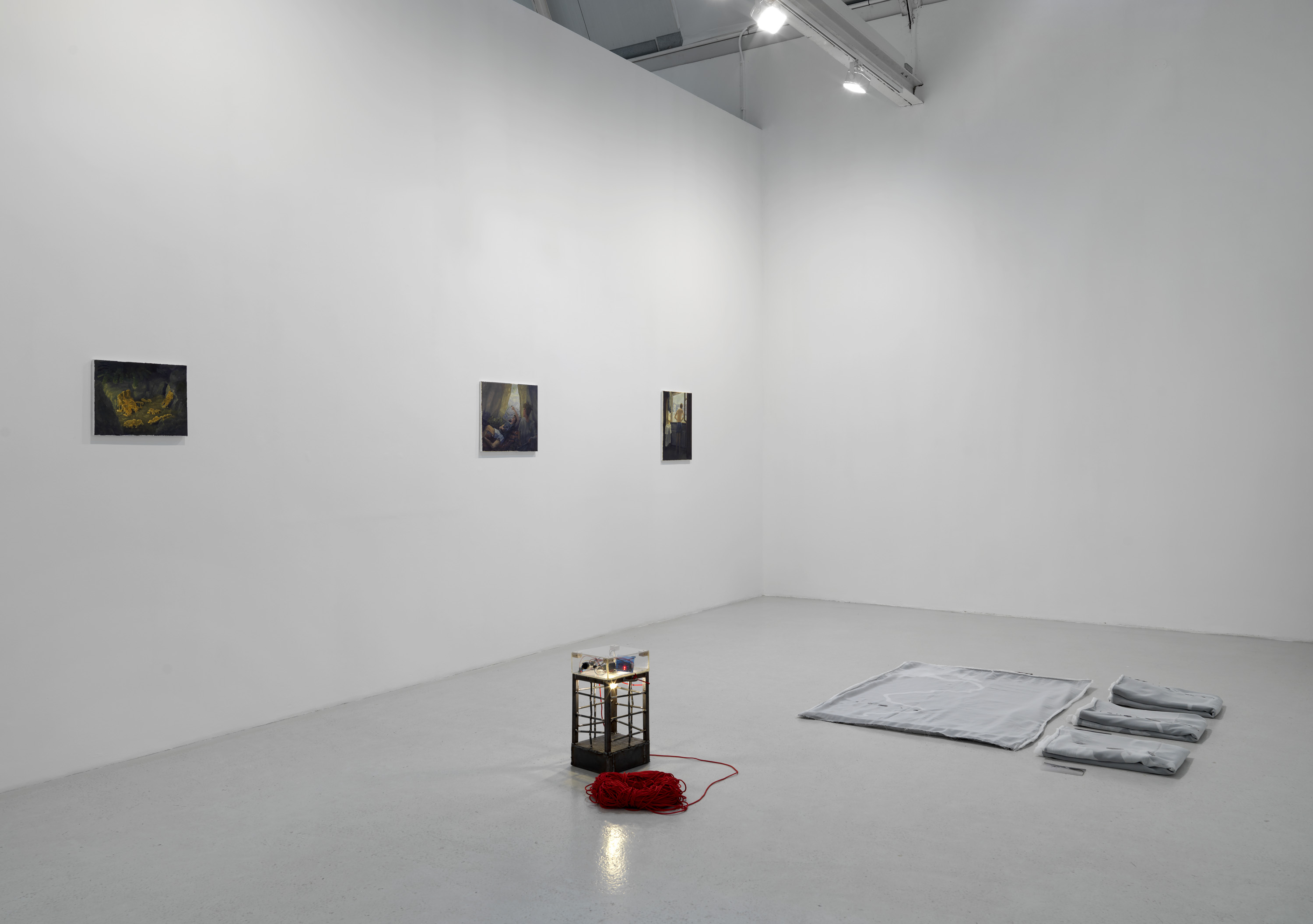


There are three artists presented in greengrassi’s latest exhibition, all working in very different ways but brought together by their subject matter: the natural world.
Felix De Clercq’s presentation Jusqu’au Rhin (Until the Rhine) presents locations that are both geographical, geological and personal. A blanket is spread across the floor in the centre of the gallery whilst three others are folded along one side, a prelude to a series of modest paintings on the surrounding walls.
4 blankets depicting the Rhine, Meuse, Thames and Scheldt on which the shapes of 36 islands of the primal river cut out of pictures of the North Sea are sewn (2021) is the title of this work. An illuminated iron structure stands close by with a red rope and another helpful title: Lantern to lower in the wells of the 10,000-year-old river in which the Rhine, Meuse, Thames and Scheldt flowed out which spells the names of the 4 rivers in Morse code (2021).
The great European rivers that run across De Clercq’s homeland of Belgium and its neighbouring countries were once tributaries of an enormous slow-flowing river, running west into the Atlantic along what is now the English Channel. Until around 10,000 years ago, Great Britain was a peninsula of Europe. The southern part of the North Sea was once a rich hunting ground for ancient people, known by archaeologists as ‘Rhine-Thames land’ or Doggerland and uniting geologically, geographically and conceptually what became known as Europe to the UK. In light of the current political implications of Brexit over fishing licenses, the work highlights the absurdity of defining and separating space that remains geologically united.
De Clercq’s lantern includes a plexiglass case containing a Morse code machine. Morse code was originally developed for maritime communication and later used for sending encrypted messages during the First and Second World Wars. Parts of these conflicts were fought above the sunken Doggerland and along the ancient river that De Clercq alludes to in his installation. Deadly battles have shaped the borders that define contemporary Northern Europe and now a politically separated United Kingdom. Morse code also alludes to distant memories of trying to invent secret languages with siblings and friends. Secret codes are still shared between intimates.
Closeness is a theme explored in De Clercq’s small-scale paintings. The masculine subjects of his canvases are depicted peering out of an open window, lighting a fire in a forest and lying together in a tent. Landscape is both a setting and a protagonist of the canvases as it becomes emotional, personal, sentient. These images are difficult to categorise. Are they taken from De Clercq’s memory, his fantasies, or are they taken from the countless images we are exposed to? Each composition is meticulously constructed, perhaps sketched onto paper before applying brushstrokes, flecks, stripes of colour that create the depths, layers and volumes of these works.
The titles mention geographical locations, Wild Camping in the Vosges (2020), Morning by the Rhine (2020), W. at a Hotelroom in Colmar (2020), referring to the cities and forests in France on the border between Germany and Switzerland. I was partly raised in this region and I associate them with fleeting memories and a childhood that has long passed. The canvases create a dialogue about discovery, intimacy, excitement, freedom and the beauty of the natural world. In one of the paintings, De Clercq shows a young man contemplating an insect as another boy watches on. A humble effort to describe the pleasure we can take in observing what we love.
The rivers mentioned in the sculptures acquire a further meaning. These are the rivers De Clercq might have encountered when traveling south from Antwerp, first the Scheldt, then the Meuse, the Rhine which all flow back into that great, prehistoric river. Jusqu’au Rhin articulates past and present journeys, both physical and internal, historical and contemporary, collective and personal. The natural and geological become references to the self.
In the other room stand works by Stefano Arienti and Jennifer Steinkamp. In Carpino Retinato (2020), Arienti takes a photograph of a hornbeam, a common tree in Western Europe, enlarges the image and later prints it onto a synthetic material that is then folded following vertical patterns. This process is also used for Controluce Retinato (2011-2019), a backlit image that captures light through a window. Taken against conventional rules of traditional photography and transforming the images through a process that highly involves the human hand, the works have depth and a structure that becomes pictorial.
Lastly, Jennifer Steinkamp’s 3D animations of floral compositions transform the category of still life into evolving dynamic subjects. Steinkamp creates every image manually with motion graphics software. As an architect’s hand is hidden in their final building, Steinkamp’s manual labour is concealed in her animations. “People watch my work for a long time” states Steinkamp, at the end of the familiar quote by Georgia O’Keefe: “no one looks at a flower. Really. One hasn’t time”.
Here one is hypnotically drawn into Steinkamp’s flowers as they move, expand, flourish, spread and recompose themselves on screen. In Floreat (2021) - Latin for flourish - there is a reflection on the capacity of nature to compose and recompose itself. The floral compositions refer to celebrations, mourning, as well as bearing witness to the daily passing of time and our constant efforts to compose and arrange life whilst waiting for someone or something to blossom.
These artists, so different, display work that is conceptually united. “I don’t have a problem with beauty; it makes you consider how you feel about things”, states Steinkamp. This quote provides comment on the different presentations of these works, that are each exquisite representations of natural elements.
Ilaria Puri Purini
Curator of Programmes
greengrassi, 1A Kempsford Rd, London SE11 4NU. Open by appointment Tuesday-Saturday 11.00-18.00. Exhibition continues until 5 June 2021. www.greengrassi.com